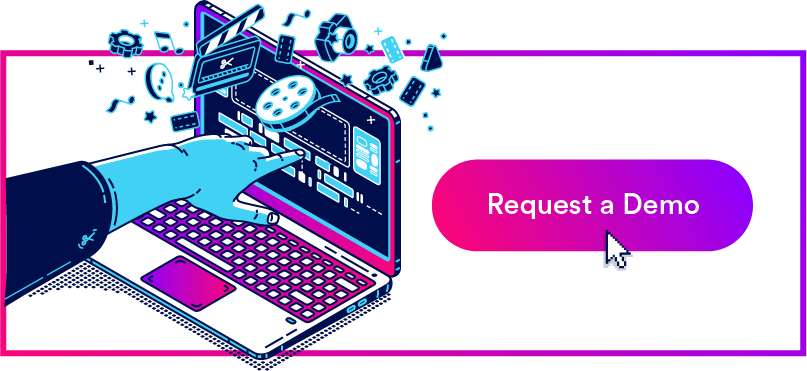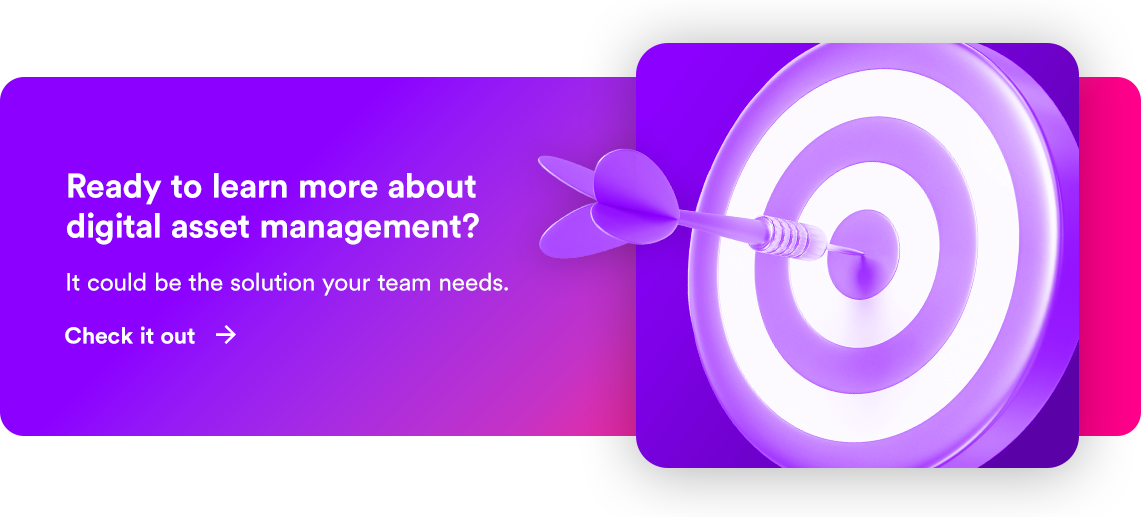- What Is a Brand Communication Strategy?
- Advantages of a Brand Communication Strategy
- Brand Communication Strategy Framework
- How Do You Write a Brand Communication Strategy?
- Step 1: Know Your Target Audience.
- Step 2: Determine Your Channels.
- Step 3: Develop a Buyer Persona and Customer Journey.
- Step 4: Determine Your Unique Selling Proposition.
- Step 5: Craft Your Messaging, Develop Your Content.
- Step 6: Establish Success Metrics.
- Brand Communications Strategy Presentation Template
- Brand Communication Strategy Starter Kit Bundle
- Brand Communication Strategy Examples
- Brand Communication Strategy Best Practices
Get branding tips and expert advice delivered straight to your inbox.
Learn how to build a powerful brand communication strategy with this complete guide, which includes step-by-step instructions, expert tips, and best practices.
Included in this blog, you’ll find a how-to framework for building a user-centered brand communication strategy, a free starter kit (with a customizable brand communication strategy template), and real-world examples.
What Is a Brand Communication Strategy?
A brand communication strategy is a plan that companies create to strengthen their branding efforts. The strategy helps identify the best ways to share a brand's core message with the target audience and how to optimize resources through different channels.
Brand managers and their team develop the brand communication strategy before they make any plans or execute. The strategy will help the business succeed in two primary areas:
Growth: By taking the time to create a strategy, you help to identify the brand messages that will make the most significant impact on your core audience. The key to crafting the most compelling, effective messaging is to have a deep understanding of your audience. In addition, your strategy and the execution of that plan are the primary factors in building your reputation, along with the satisfaction and trust with your customers. The more customers you gain through focusing on their needs, the higher the conversion rate for your business, leading to greater profits. The best method for growing profits in today’s market is to increase customer awareness and develop customer loyalty through a customer-centered lens.
Resource Allocation: A strong communication strategy also helps you to identify the channels that will deliver the highest returns in audience engagement. Especially if you have limited resources, a communication strategy shows the highest potential return on investment (ROI) for your time and money. When you have a strategy, you can easily track the effectiveness of your brand communication efforts and make informed resource allocation decisions.
Grabbing consumers’ interest is the primary goal of your communication plan. Your brand has little chance to make itself known without a brand communication strategy. Because consumers encounter brands through multiple channels, many times each day, even the smallest interaction counts against tight competition. Successful branding is no longer as easy as talking to customers — it’s about weaving the brand into their daily life through meaningful, consistent engagement across platforms.
A brand accomplishes its objectives through communication, starting with knowing exactly who’s interacting with your brand. Anat Baron, brand builder, futurist and keynote speaker, points out that “so many brands mistakenly care about what they have to say and what they have to communicate, but it starts with really homing in on what the audience thinks. We no longer have access to ‘the masses’ with the change in how we consume. Before the internet, there was never an ability to have two-way communication with your audience. Now, everything is much more on-demand, and people can search on their own. Plus, everyone’s a content creator. It’s exponentially harder to get customers’ attention. If you can’t get their attention, the best strategy is going to fail.”
Anat lists four questions to ask to build a strong brand communication strategy:
- Who is my audience?
- Where do they hang out?
- How am I going to reach them?
- What am I going to reach them with? (This question helps define the messaging, then becomes the tactic.)
Advantages of a Brand Communication Strategy
In today’s saturated market, a brand communication strategy offers the advantage of helping you to secure your position within the market, which in turn motivates consumers and cultivates brand loyalty. For small businesses, this can build trust and relationships with consumers and lead to scaling more quickly. For large enterprises, a well-crafted strategy can set you apart from your competition and increase your loyalty and conversion rates.
Remember, you have to outline your strategy before writing a detailed brand communication plan, which is the organizing tool that makes your strategy happen. The tactics that you develop from a brand communication strategy give your business an advantage to optimize business goals, marketing strategy, content creation, and communication channels, as outlined below:
Business Goals
- Improve Your Offering: Use feedback from communication channels to identify consistent problems from customers and make changes to your product, service, or experience. Use customer feedback as a mirror to see if your product is differentiated enough to secure your place in the market as an authority.
- Make Your Product a Must-Have: You can accomplish this by understanding your position in the market and optimizing market strategies. Start with thoroughly listening to your audience to gain insights into how to reach them.
- Increase Your ROI: As you determine the most effective approaches, you can eliminate ideas that don’t work well and focus more resources on what delivers effectively.
- Confirm Your Brand as an Authority: Consistent branding is a part of placing your brand at the top. Authoritative brands that become household names achieve inherent growth through word of mouth and retain customers through a high switching cost.
Marketing Efforts
- Optimize Your Approach: Analyze your collected data to gain insight into how best to build your marketing strategy. Keep creativity as a centerpiece to engage and entertain your target audience.
- Increase Reach: Determine a multi-angled approach for reaching your audience. Identify messaging approaches specific to where a buyer is on their purchasing journey.
- Build Targeted, Unique Campaigns: Consumers interact with brands across several touchpoints, often without a specific funnel. Your marketing must focus on integrating the same message consistently across platforms, because your customer’s first point of entry is unpredictable.
Content Creation
- Create Effective Messaging: Use your research to develop premium quality content that delivers value on all channels. Include a short- and long-term narrative-driven plan to build customer loyalty.
- Build an Emotional Connection: The best brands know that consumers respond based on an emotional reaction and strong companies are built on trust. Being relatable and human-centered creates the strongest bonds.
- Stand Apart: Anyone can create content today, and almost 80 percent of available content is now user-generated. Use detailed research to write creative content that sticks and communicates your values. Even better, tap into your users to have them co-create content.
Communication Channels
- Use Tailored Communication: Organizations with the most competitive strategies know where to play and how to win. Your strategy work can help you reveal untapped channels or places you’ve overlooked in the past. By tailoring your communication to your users and channel, you increase the chances of the message resonating with your audience and moving them through your sales funnel.
- Drive Relationship Engagement: Use technology to your advantage by fostering a relationship with your customers. Engagement is expected in today’s two-way brand communication.
- Identify Brand Ambassadors: Open another channel by enabling your customers to share your messaging. Give them the tools and talking points in your campaigns to help them organically share details about your brand to their own following.
Brand communication strategies also use messaging tactics to improve communication. The better your communication, the more likely that your audience will have a positive, memorable experience. More memorable experiences, in turn, increase sales.
Internally, a brand communication strategy aligns departments, agencies, managers, and designers to the brand and keeps your messaging consistent, regardless of the specific team members involved.
Graham Robertson, Founder of Beloved Brands, Inc., sees a brand communication strategy as a tool “to provide clear direction to those who will execute on behalf of the brand. The brand communication plan acts as an organizing tool to ensure everyone has specific marching orders on the particular strategy related to their function, leaving no room for misinterpretation.”
The role of brand communication strategy also plays a part in a larger marketing strategy to increase profits by growing the brand’s reach. This includes building brand awareness and brand equity to convert customers to loyal brand advocates. And it helps you know which channels to focus on when building customer relationships.
What Is an Integrated Brand Communication Strategy?
You can create an integrated brand communication strategy to standardize customer touchpoints across platforms. Doing so ensures that your customers get the same message each time they connect with your brand and seamlessly weaves your brand into daily life.
When customers need a solution to a problem, companies that are consistent and memorable across channels are the first that come to mind. This indicates a high degree of brand salience.
You can also use an integrated brand communication strategy to fulfill the brand promise by using existing brand pillars to hone the brand personality and to promote those personality traits consistently, via the brand’s strategy.
Companies use distinct brand assets as part of their integrated brand strategy to signal familiarity through visual designs, messaging, and other creative tactics. The consumer recognizes the brand through these signals, though the integrated strategy might use an approach that differs from the brand's core campaign. Organize this content with a brand asset management system — this includes ad campaigns that capture the attention of the target audience through ads that use storytelling to share the brand’s values, even if they don’t have a call to action.
For example, Dove’s personal care campaign reached beyond its array of body products to celebrate beauty from the inside out. The company’s integrated campaign, “Real Beauty,” focused not only on its products and target audience, but also on the greater issues of women’s body perception. The campaign tactics raised public conversations through social media, targeted billboards, and video ads. The content questioned current beauty industry trends, messaging, and expectations of women’s bodies. Following this first strategic phase, Dove partnered with nonprofits and organizations aimed at promoting self-esteem and confidence. This integrated strategy resonated with their audience’s values, and at the same time promoted the product as an influential factor to living those values.
Brand Communication Strategy Framework
A brand communication strategy framework is the structure a team uses to determine the brand's direction. Each framework aims for the same goals: Understand the target audience, determine communication channels, decide objectives, and create core messaging to increase customer engagement.
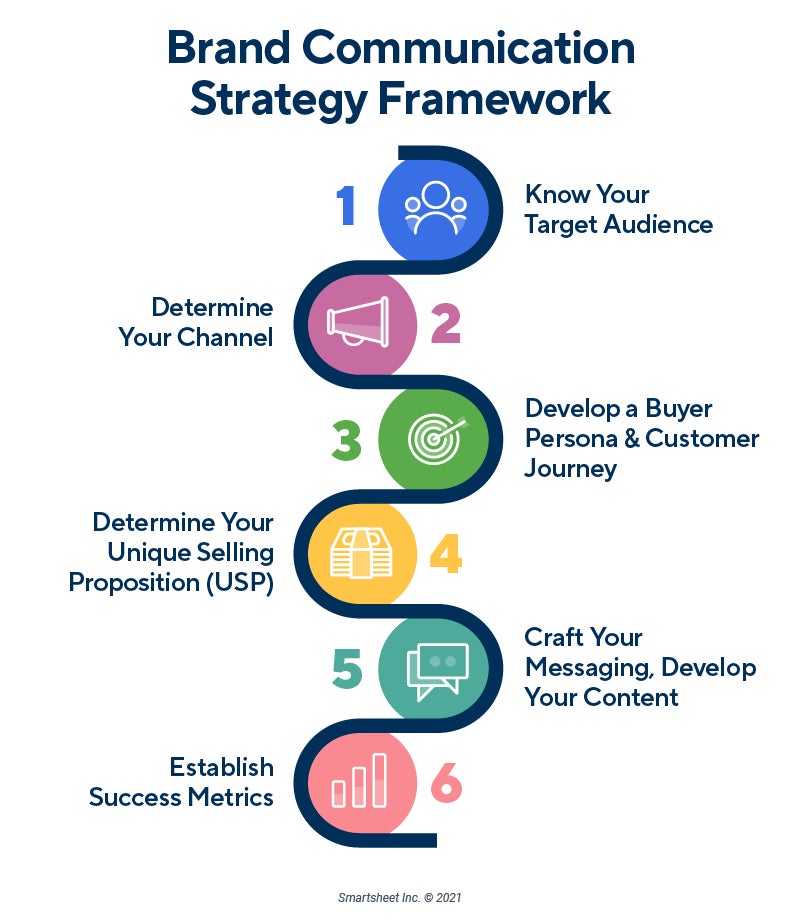
How Do You Write a Brand Communication Strategy?
Writing a brand communication strategy starts with a deep understanding of your consumers. Research your target audience, analyze which content will be most engaging to them, and determine which channels your audience uses to craft your messaging.
Before starting your brand communication strategy, clarify why you need one and how it serves your greater business goals. Make sure you’ve established your business objectives, thoroughly analyzed the market, and performed research on competitors.
Steps to Writing a Brand Communication Strategy We’ve broken down the writing process into a pre-writing step and six easy-to-follow steps, with tips from Anat Baron.
Pre-Writing Step: Determine Your Communication Objectives: Identify your business stage before you start writing your brand communication strategy. A startup, small business and large enterprise all have different objectives. For example, it can inform potential customers, develop partnerships, raise brand awareness, create demand, educate consumers, increase conversion rates, build loyalty, rebrand, or become a household name. Be specific and realistic about where you’re starting to position yourself on the sturdiest foundation.
Step 1: Know Your Target Audience.
Research your target audience. Who are they? Define the “who” of your target market based on customer insights. Conduct market research to determine your ideal customer’s demographics, what channels and spaces they frequent, what motivates them, and which competitor’s offerings they value.
Tip: Think about the audience on the other side. Before you can develop a strategy, you have to think about the “who.” These are the details that get missed the most.
Step 2: Determine Your Channels.
Analyze the specific areas where your ideal customer consumes information and is most likely to engage with your brand. Customer brand awareness and engagement occur via touchpoints through a variety of channels. The more targeted opportunities your audience has to understand your brand’s personality, the higher the potential conversion rate. Start with prioritizing your target audience’s frequent channels. Consider the following:
Digital Marketing:
- Blog posts
- Digital ad campaigns
- Email marketing
- Influencers
- Podcasts
- Search engines
- Social media
- Website landing pages
- Video-hosted content sites
Traditional Marketing:
- Ad campaigns
- Billboards and print media
- Commercial advertising (radio and TV)
- Direct response campaigns
- In-store experiences and events
- Press releases
- Promotional mailings
- Sales brochures
At this point, consider the style of content your audience will consume in relation to each channel. For example, user-generated content is increasingly popular because it both engages your audience and produces content for free. However, be sure that user-generated content is consistent across all channels. Using an integrated brand communication strategy helps ensure your customers experience your brand in the same way, regardless of how they encounter it or which party creates it.
Tip: These first two steps are key. Once you identify the best channels needed to reach your audience, answer the following questions:
- What kind of content might get their attention?
- What kind of content is going to get engagement?
Step 3: Develop a Buyer Persona and Customer Journey.
Create a buyer persona that represents a segment of your target audience. This persona includes your customer’s motivations, wants, needs, and pain points. After creating the persona, complete a customer journey that walks them through each buying funnel from brand awareness to purchase.
Step 4: Determine Your Unique Selling Proposition.
Claim your offering’s unique position by differentiating it from its competitors. Brainstorm messaging for your brand’s uniqueness by creating specific messaging for each stage of the buyer’s journey that will ultimately help move the customer to a purchase. Post-purchase is also a crucial part of your brand communication strategy to cultivate existing customers as brand advocates.
Step 5: Craft Your Messaging, Develop Your Content.
Formulate your underlying core message throughout all of your channels and buyer stages. The most effective messages are simple and resonate emotionally with the audience. From this core message, develop content for each channel and stage within the brand style guidelines. Focus on the key differentiators of your positioning strategy and the value you offer for that position. If you’re hiring an external agency or need to communicate brand specifics across a large team, write a brand brief to keep all teams in line with your brand essentials.
Tip: Filter your content through your target audience lens by asking the following vetting questions:
- Why do they care?
- Why will they click Buy?
Pass any content you create through these questions before moving forward. Doing so will help you avoid the common mistake of focusing on the details you worked on, rather than what interested the customer.
Step 6: Establish Success Metrics.
Establish what you are measuring based on the goals of your communication strategy. Your metrics need to be specific and evaluated, either qualitatively or quantitatively, and should focus on one of the following:
- How your consumers perceive your brand
- How they behave or interact with your brand
- How people purchase or use your brand
- How your brand communication strategy impacts financials
Some example metrics include the following:
- Click-through rate
- Comment quality
- Conversion rates
- Follows or likes
- Leads attained
- Mentions or links on external channels
- Number of comments
- Number of inquiries, downloads, subscriptions, or clicks
- Response rates or time spent on a website
- Social shares
- Website traffic
Tip: Focus on creating customer loyalty. Use the democratization of communication, such as user comments, to your advantage to collect data for your next steps.
Brand Communications Strategy Presentation Template
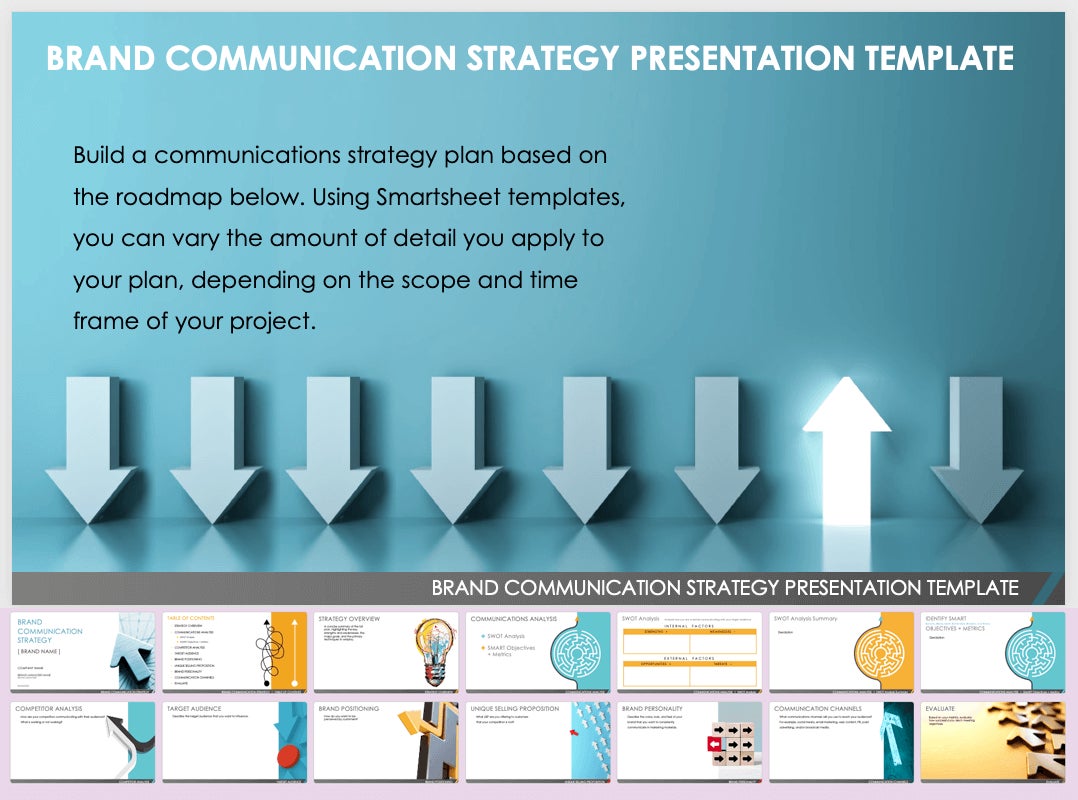
Create and present a thorough brand communications strategy in line with your brand strategy by downloading this free brand communications strategy presentation template in Microsoft PowerPoint and Google Slide formats. This template includes a SWOT analysis of your current communication methods, measurable objectives, a competitor analysis and more to help you evaluate the success of your communications strategy.
Brand Communication Strategy Starter Kit Bundle
Establish your most impactful brand communication strategy with this comprehensive template bundle. The bundle includes a brand strategy brainstorming worksheet, a brand strategy roadmap template, a brand communication strategy template, a brand marketing strategy template, a brand communication channels template, and a brand strategy scorecard template. From the foundational work of determining your brand strategy assets to tracking your metrics, these templates support your brand communication strategy from start to finish.
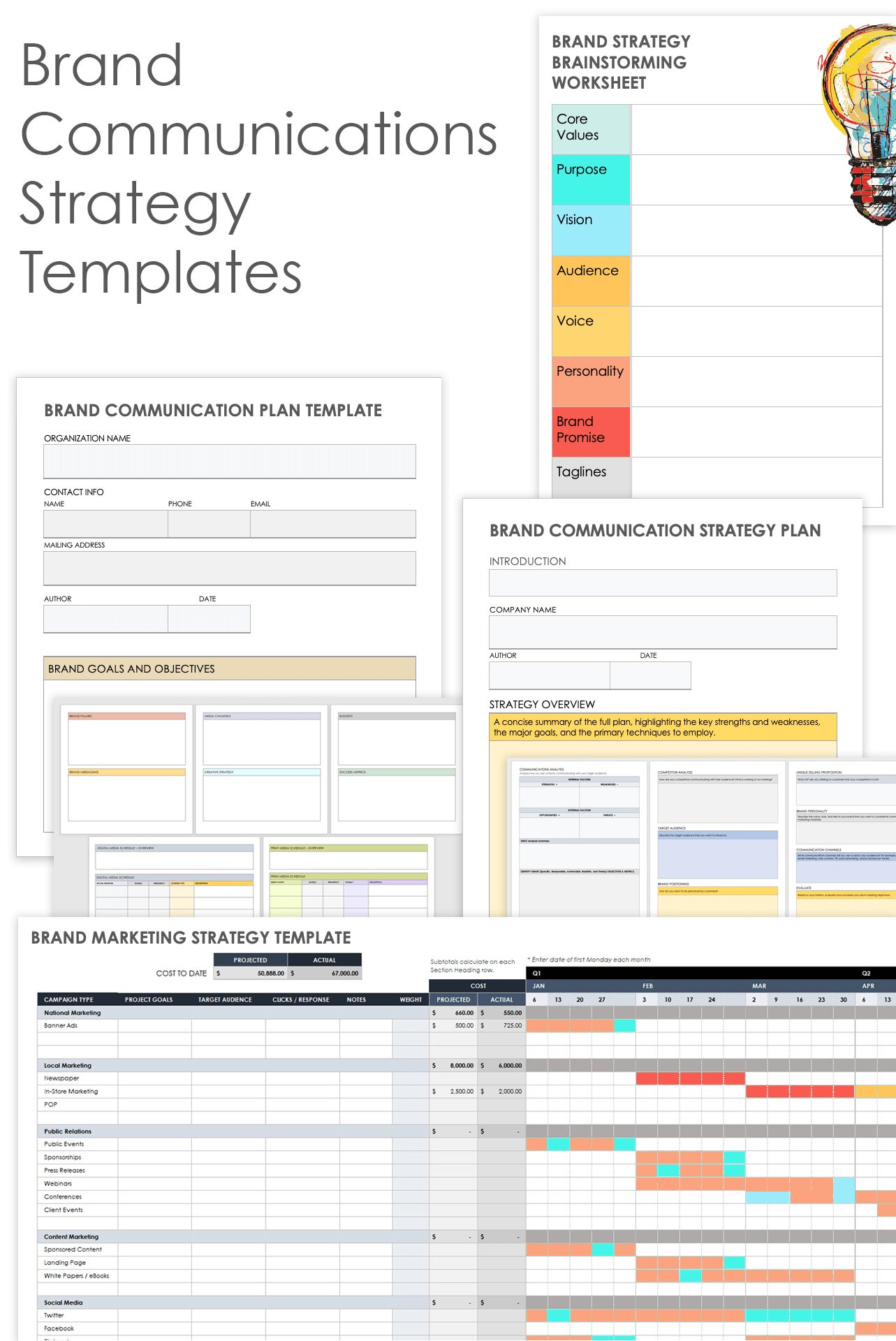
For the most thorough selection of free brand strategy templates, visit our roundup of free brand strategy templates.
Brand Communication Strategy Examples
These examples of brand communication strategies display a range of successful approaches, from Apple’s impenetrable integrated strategy to Aston Martin's multi-angled method to maintain its desirable luxury brand in a class of its own.
Apple
From its first “Think Different” slogan, Apple has been leading the way in establishing its marketing as a household name. Apple’s well-known brand integration is an airtight powerhouse, and the company further uses PR to create excitement around any new product release and its distinctive features, such as its high-quality camera. Apple Insider captured Adweek’s keynote speaker Tor Myhren’s (VP of Marketing Communications) on iPhone’s long-running “Shot on iPhone” campaign: “It was a “ridiculously simple idea ... based on behavior we were seeing with people posting their photos and hashtagging them in different ways."
The campaign focuses on promoting the capabilities of the product (such as battery endurance, editing effects, and visual quality) both in-house and from users, which naturally creates exciting visual content for Apple. The company additionally hosts a shot challenge, with the 10 winners’ photos featured on billboards, retail stores, and online across the world. Recently, Apple has released educational tips for creating more cinematic and creative videos through its film technique shorts.
Southwest
Southwest focused its “Transfarency” campaign around the needs of its target audience. In a press release, Ryan Green, Vice President and Chief Marketing Officer at Southwest, launched the campaign as “an opportunity for us to remind the world that there is a personal reason someone chose to fly Southwest Airlines with our low fares, no hidden fees, and exceptional hospitality.” This aligns with its overall core brand of customer care first, as demonstrated by its heart logo.
Aston Martin
The luxury car brand’s strategy is a multi-pronged approach to increasing its brand reach. The company’s 11 focus areas of its public strategy involve a three-pillar product strategy, including increasing desirability through an exclusive car model and re-envisioned customer journey. Gerard Fourie, Aston Martin’s Director of Marketing and Brand Strategy, shared insights on shaping the digital and in-person experience: “The most valuable thing is just talking to customers and having them explain where the product fits into their lives, how the purchase experience or experience of the product has worked for them, what they would like to see improved. We get much more interesting and richer feedback from those one-on-ones.”
This data is used to drive personalized experiences through their digital and in-person touchpoints with consideration to cultivating customers long-term. “The role of the website and car configurator is to converge with customers today, and maybe customers who will be ready to buy in 5, 10, 15 years. Once a customer has indicated they’re ready, then it is our job to make sure their journey is as frictionless and rewarding as possible. Brick and mortar and digital are not two different parts of the experience.”
Domino’s
Domino’s phased its “AnyWare” communication strategy by first improving its ordering experience through dedicated customer profiles. The company expanded this personalized experience by revolutionizing the method and location of how to order. Now, customers can use the ordering method that’s most convenient for them instead of visiting the dedicated website. Domino’s former Head of Sales and Marketing Tony Holdway made two-way communication easy for customers by using social media, texting, car syncing, and more to make ordering a pizza less than one click away. He shares in an interview with AI Creative, “From a digital perspective, over three-quarters of our sales are through devices. We’ve got a lot of data as a result. Using that data to inform email/SMS push, etc., and the website journey and dynamically changing the website journey is key in going forward.”
Brands have to continuously be in front of technology. Looking ahead, brands must shift their marketing to be the best. Dominos is exploring the next stage through artificial intelligence. Holdway says, “The worry for brands is that a Google search serves you up the first page of results. But voice assistance probably serves you one result. Are you that one result? I think that’s why brands need to be dominant and well ahead of their competitors so that in all of those individual searches they are the served-up result.”
Airbnb
Airbnb has a demonstrated commitment to making its partner hosts offer a unique place (experience) that feels like home. One of its most successful communication strategies focuses on user-generated content in its two-way platform business model. In 2021, the company launched its “Made Possible by Hosts” campaign to increase its brand-building. According to Marketing Weekly, the campaign’s focus aimed “to educate guests about the benefits of being hosted and to inspire more people to become hosts. It launched on television and digital channels across the business’s five largest markets.”
In the same article, Airbnb Co-Founder and CEO Brian Chesky, shared that Airbnb takes a “very different approach to sales and marketing than our competition. PR, in addition to word of mouth, is the thing that built our brand over the last 10 years.” The company “now looks at the role of marketing as ‘education,’ not ‘to buy customers.’”
KitchenAid
KitchenAid offers a reliable mixer kitchen staple that has long been a part of U.S. kitchens. The company recognizes consistency and customer satisfaction as a key part of its strategy, responding to the home-baking wave through product placement on baking shows and nostalgic happy-at-home social media images. Its most recent “Marks” campaign used innovative YouTube moment marketing to tailor the messaging delivery based on users’ initial interaction.
Christina Hopkins, Whirlpool’s Shopper Marketing Director, explained the company’s campaign tactics: “We started with a base piece of content … we made a 15-second story that we served up to our audience. We then paid attention to how they were engaging with that content. Did they skip it or did they watch it? And that determined what the next step would be for us.” If the viewer skipped the ad, the next ad would be a required 6-second ad to get their brand message across to the consumer. If they watched the ad, the viewer would get a 30-second ad next as part of a consecutive narrative.
Tony Robbins
Tony Robbins is a pillar in personal branding. His values and life coaching are consistent throughout his audiobooks, podcasts, leadership seminars, and social media presence. He is an expert at building rapport with his audience and resonating with their need to become better people through self-accountability. In an interview with I Love Marketing, he shares that building a personality brand is hard work. He describes that he “became a brand because I innovated and marketed continuously, and I still do.”
Chanel
Chanel is an exceptional example of following social media trends via a strong communication strategy. Chanel’s luxury brand balances its customer’s desire for almost-unobtainable sophistication with a nonchalant everyday air. The company is known to feature models who embody this duality through high-end print media, ad, and social media campaigns to assertively drive website traffic. In Analysis of Chanel’s Marketing Wang Zihan says, “Chanel has extremely strict control over the media of advertising, which must be closely related to the target consumer groups of Chanel, such as fashion magazines, high-end hotels or clubs, etc. In terms of the number and cycle of advertising, Chanel is targeted and planned, and their advertising requires precision rather than wide coverage.”
Taco Bell
Taco Bell knows its target audience and isn’t afraid to cater to them. The company’s late-night brand affiliation continually revises its communication strategy to reach its target market and has recently shifted to digital orders. Former Global Chief Brand Officer, Nikki Lawson, commented on the shift with Forbes: “We are exploiting a behavior that already exists. We’re making it easier for customers, and it also makes it simpler for us to process orders in the back of the house — the customers are making it simpler for us.”
The company used celebrities to promote the launch, a common tactic with large brands. Lawson continued on the strategy, “The celebrities aren’t sharing their favorite orders, but reminding our customers to do their own thing. Our customers almost wear it like a badge of honor — playing with our products, creating and customizing … we want to value creativity over confinement and show that, yes, celebrities love Taco Bell, but their favorites are just as important as yours.”
Brand Communication Strategy Example
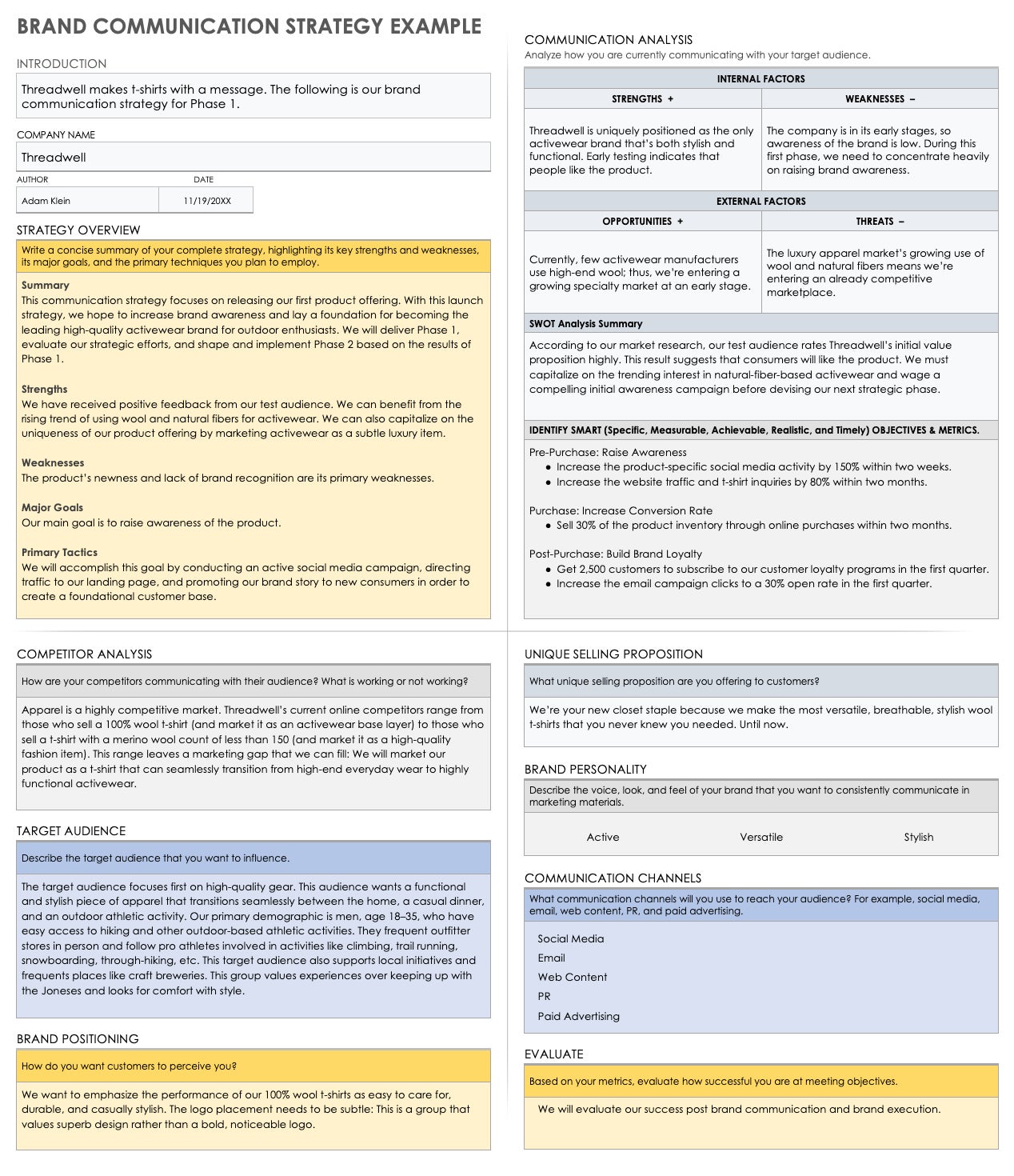
Every brand communication plan starts with a strategy. If you’re stuck on how to start your next great brand communication strategy, use this pre-filled, customizable brand communication strategy example template to learn the basics of building a strong communication strategy.
Brand Communication Strategy Best Practices
Best practices for brand communication strategy starts with a keen focus on your target audience. From there, focus on relating clearly and authentically to your customers. Advanced best practice helps your existing customers become an advocate for your brand.
Here are some expert-tested tips to keep in mind:
Authenticity, Honesty, Transparency: Customers can read through cheap sales tactics. Be real, especially when sharing the challenges you’ve overcome or hardships. Customers don’t buy perfection or overselling.
Content: Vary your content — make sure you have 10 to 20 percent of fun content purely for consumption or to help your customer without an ask. Test your content to make sure it’s engaging and relatable before you launch your campaign.
Versatility: Be flexible in approaching your content without limiting yourself to a specific delivery method or style.
Dialogue: Include customers in the conversation. Engage them through feedback loops, content creation, surveys, and challenges to keep a pulse on their perception and place your product at the forefront of their interest.
Customer Advocates: Develop brand ambassadors. Word of mouth is an excellent channel.
Customer Experience: Start with the customer experience, rather than by simply sharing the hard work of your product from your perspective. Instead, connect to what your customers value.
Let Go: Developing a brand communication strategy takes a lot of effort. But it’s important not to get stuck on bad ideas simply because of the time spent creating them. Instead, evaluate your ideas from a consumer’s perspective and learn to toss ideas that don’t apply to your specific focus.
Graham Robertson sees the biggest mistake people make: “Especially in our digital era, [people go] for the short-term transaction with the marketing. We need to balance brand-building and transactions. Push for a powerful connection, and know it will pay off in the long term. Higher connection drives more profit.”
He also encourages people to leave room for creativity by “balancing efficiency with impact. Lately, marketers are focused on the little things, because they trust it will make consumers click and buy. We have to leave a bit of room for the unknown creativity to shine through, to make sure your words will inspire magic.”
To learn more about brand strategy and the best ways to drive brand impact, check out our webinar: The Digital Sweet Spot: Where campaign quality and efficiency intersect for brand impact.

